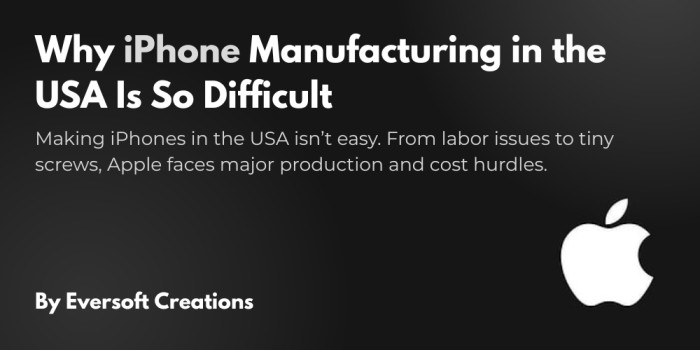In these past months, people have focused more on the idea of manufacturing jobs returning to the United States. Once again, the subject of iPhone manufacturing in the USA is being discussed in political and economic circles — due to recent issues around trade, tariffs and more attention on relying on the country’s resources.
While at first, the idea appears to be good for both the country and the economy, the fact is that achieving it is incredibly complex thanks to problems with supply, workers, technology and rising expenses. We will explore here why it is challenging to build iPhones in the US, clearer with the story of those tiny screws.
The Tariff Trigger: A Political Push for Domestic Manufacturing
Under former President Trump and now supported by some officials, the U.S. government explored imposing a 25% tariff on iPhone and similar phones made outside the country. This policy works to motivate US manufacturing by making offshore production more expensive.
Still, in practical terms, there are huge economic and logistical problems that go along with this approach. Tariffs can help save domestic jobs, though with iPhones, people could end up paying a lot more and seeing fewer available iPhones.
Why iPhone Manufacturing Isn’t Just About Assembly
It is widely assumed that the biggest problem when working on an iPhone is putting it together. The truth is, putting together an iPhone assembly is just the start. iPhones consist of thousands of parts gathered worldwide. Apple’s supply chain covers 43 countries and includes hundreds of different suppliers.
This system which took decades to optimize, is now extremely efficient and low-cost, but it’s nearly impossible to create within the United States.
The “Little, Little Screws” Problem
Howard Lutnick, the Commerce Secretary, discussed a subject many ignore — the manual effort that goes into making iPhones. By talking about “millions and millions of human beings fitting in small screws,” he showed how much effort was involved in building products today.
It would be both difficult and expensive to perform this kind of work in the U.S. Even though automation is sometimes touted as a simple fix, Apple CEO Tim Cook says that the advanced technology needed for precise iPhone production is not yet ready.
Automation: A Futuristic Solution That’s Not Quite Ready
It is widely believed by some U.S.-manufacturing supporters that automation can overcome the problem of short labor supply. Although robots are useful for repetition, putting together iPhones requires skills and decision-making that only humans can do at present.
In addition, the cost of building advanced robotic facilities would be incredibly high. Even if Apple made these factories in the U.S., it might still take months or even years, to reach the same efficiency found in Asian factories.
The Cost Explosion: From $1,200 to $3,500?
One of the biggest risks of making iPhones in the U.S. is the added cost to consumers. If all iPhones were produced in the U.S., experts think the price could rise from $1,200 to as high as $3,500.
This is due to:
- Higher labor costs
- Increased material expenses
- New infrastructure and supply chain development
- Slower production cycles
If Apple continued with these sudden price increases, only wealthy buyers would be able to buy an iPhone.
Specialized Skill Gaps in the U.S. Workforce
Finding appropriately qualified people to fill key positions is also a problem. Many workers at China’s manufacturing hubs do not gain employment only because of their low pay – they get hired to do complex and detailed tasks.
It has been clear to Apple that there are not enough workers with the necessary skills in the U.S. to help produce iPhanes on a scale they require. It would take years and a lot of money to assemble all the training and skills necessary.
Infrastructure and Supplier Ecosystem
In China, Foxconn’s operations are part of a developed system, so suppliers are close by, often just minutes from the main factories. It greatly lowers the amount of time and money spent on transport.
By contrast, the U.S. does not have a closely connected supply chain network. It would take many industries cooperating for a long time to build this kind of ecosystem from the beginning.
Legal and Political Ramifications
Choosing one of these paths has its own set of risks. People in the field claim that chamber IEEPA could result in legal cases and pressure from countries involved in global trade.
Environmental and Sustainability Considerations
Going ahead with American production could actually increase certain forms of environmental harm. Efficiency in energy and use of resources is given importance along with cost in existing Asia-based manufacturing centers. The first phase of building plants from scratch in the U.S. would lead to a rise in carbon emissions.
What Could Be a More Realistic Path Forward?
Since wide-scale manufacturing is unlikely, halfway models might present a good compromise.
- Establishing select assembly plants in the U.S.
- Creating more R&D and prototyping centers
- Building supplier relationships gradually
The step-by-step method may decrease dependence on foreign factories without badly hitting the economy.
Conclusion: A Complex Vision with Many Moving Parts
Building iPhones in the U.S. isn’t only about relocating some factories; it means creating an entirely new global system. Issues in training the workforce, automating processes and dealing with costs and international conflicts are huge.
As much as the image of “American-made iPhones” may appeal to national pride, it’s clear that the path to achieving that vision is long, costly, and filled with tiny — yet significant — details like those “little, little screws.”
Interested in More In-Depth Tech and Economy Insights?
Explore our Eversoft Creations for more expert analyses, latest news, and thought-provoking blogs on technology, manufacturing, global trade, and more. Stay informed and stay ahead with our in-depth content tailored just for you.



